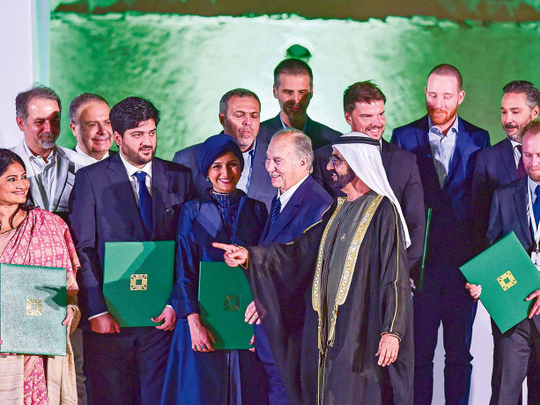
Al Ain: The people behind the creation of what has been judged the Muslim world’s six best new structures scooped up a Dh3.67 million prize on Sunday, in a sparkling ceremony held at the historic Al Ain fort.
The prizes for the six winners of the Aga Khan Award for Architecture were presented by His Highness Shaikh Mohammad Bin Rashid Al Maktoum, Vice-President and Prime Minister of the UAE and Ruler of Dubai.
Shaikh Mohammad and his entourage had earlier arrived at Al Jahili fort, its towering walls bathed in flood-lit green to mark the occasion.
The Award honours the ideal of marrying modern design and the needs of Islamic communities. We thank His Royal Highness, the Aga Khan. pic.twitter.com/xqifdAoADE— HH Sheikh Mohammed (@HHShkMohd) November 6, 2016
I was delighted today to witness the award of the Aga Khan Award for Architecture at the beautiful Al Jahili Fort in Al Ain. pic.twitter.com/M9JQB3tDwt— HH Sheikh Mohammed (@HHShkMohd) November 6, 2016
As he walked through 125-year-old fort’s arched stone entrance, a hushed silence fell over the crowd of architects, urban planners, award officials and journalists.
Joining Shaikh Mohammad on the stage to present the prizes was Prince Karim Aga Khan, the spiritual leader of around 15 million Ismaili Muslims and the award’s creator.
video: . @HHShkMohd honors winners of the Aga Khan Award for Architecture pic.twitter.com/atqvIEwvY4— Dubai Media Office (@DXBMediaOffice) November 6, 2016
Just before, shortly after sunset, as the ceremony began, a six-member band played a 15-minute musical composition with traditional Afghan, Indian and Chinese instruments.
On the giant stage overlooking the outdoor courtyard of the fort, specially covered in acres of beige and red carpet, the Aga Khan spoke.
“Great architecture can integrate the past and the future,” said the Aga Khan. He noted the contrast between the historic fort as the site of the ceremony and the swooping, modern designs of many of the winning projects.
“We need not choose between looking back and looking forward. They are not competing choices, but healthy complements,” he added.
Recalling when the award first began, close to four decades ago, the Aga Khan said that “a rash of modernising, westernising enthusiasms” had put the “rich traditions of Islamic architecture” at risk of being lost.
Speaking on the importance of pluralism, which he called the “sacred principle of these awards”, the Aga Khan said that “great architecture” has always been pluralistic in nature.
“This acceptance of different beliefs, traditions and cultures does not require us to leave behind our cherished identity,” he said.
The 19 shortlisted comprised architects, financiers, and community members who award officials had judged to have paid key roles in the building of the projects. Three of the awardees were women architects.
Unlike similar awards, the Aga Khan Award for Architects seeks to highlight structures that help the surrounding communities — countries where Muslims live — rather than just the architects themselves.
The six winning projects of this award cycle include a mosque and social space in Bangladesh, a children’s library in China, an urban park in Denmark, a university building in Lebanon, and a bridge in Iran.
Held once every three years since the late 1970s, the award is one of the arms of the Aga Khan’s Dh2.3 billion development network. From its base in Geneva, Switzerland, the award seeks to promote buildings and structures that benefit Muslim communities.
The winning structures were selected by a nine-member jury out of 348 submissions from 69 countries.
The Aga Khan, 79, heads the award’s steering committee, a de-facto board of trustees.
Winners will receive a share from a pot of Dh1.83 million in cash to spend as they please — a sum jokingly dubbed by organisers as ‘Ferrari money’. The other Dh1.83 million will be handed out in grants of their choice.
Award officials say the historic fort, which was built in the 1890s by the grandfather of the UAE’s founder, Shaikh Zayed Bin Sultan Al Nahyan, was chosen because it represents Al Ain’s place and stature in the Islamic world.
While Al Ain is far less well known than the UAE’s two largest cities, Dubai and Abu Dhabi, it carries cultural clout. The city is the only place in the UAE to contain Unesco World Heritage sites, a distinction held since 2011.
Previous venues for award ceremonies include sites famous across the Islamic world, including an Ottoman palace in Istanbul and the gardens of a Mughal emperor’s tomb in New Delhi.











